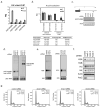Ars2 promotes proper replication-dependent histone mRNA 3' end formation
- PMID: 22244333
- PMCID: PMC3269315
- DOI: 10.1016/j.molcel.2011.12.020
Ars2 promotes proper replication-dependent histone mRNA 3' end formation
Abstract
Ars2 is a component of the nuclear cap-binding complex that contributes to microRNA biogenesis and is required for cellular proliferation. Here, we expand on the repertoire of Ars2-dependent microRNAs and determine that Ars2 regulates a number of mRNAs, the largest defined subset of which code for histones. Histone mRNAs are unique among mammalian mRNAs because they are not normally polyadenylated but, rather, are cleaved following a 3' stem loop. A significant reduction in correctly processed histone mRNAs was observed following Ars2 depletion, concurrent with an increase in polyadenylated histone transcripts. Furthermore, Ars2 physically associated with histone mRNAs and the noncoding RNA 7SK. Knockdown of 7SK led to an enhanced ratio of cleaved to polyadenylated histone transcripts, an effect dependent on Ars2. Together, the data demonstrate that Ars2 contributes to histone mRNA 3' end formation and expression and these functional properties of Ars2 are negatively regulated by interaction with 7SK RNA.
Copyright © 2012 Elsevier Inc. All rights reserved.
Figures





References
-
- Collart D, Ramsey-Ewing A, Bortell R, Lian J, Stein J, Stein G. Isolation and characterization of a cDNA from a human histone H2B gene which is reciprocally expressed in relation to replication-dependent H2B histone genes during HL60 cell differentiation. Biochemistry. 1991;30:1610–1617. - PubMed
-
- Collart D, Romain PL, Huebner K, Pockwinse S, Pilapil S, Cannizzaro LA, Lian JB, Croce CM, Stein JL, Stein GS. A human histone H2B.1 variant gene, located on chromosome 1, utilizes alternative 3′ end processing. J Cell Biochem. 1992;50:374–385. - PubMed
-
- Diribarne G, Bensaude O. 7SK RNA, a non-coding RNA regulating P-TEFb, a general transcription factor. RNA Biol. 2009;6:122–128. - PubMed
Publication types
MeSH terms
Substances
Associated data
- Actions
Grants and funding
LinkOut - more resources
Full Text Sources
Molecular Biology Databases
Miscellaneous

